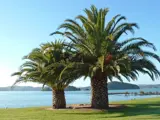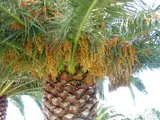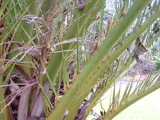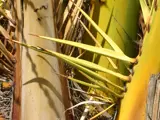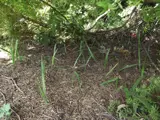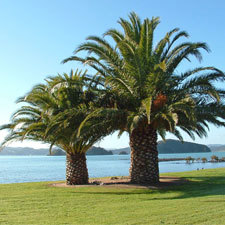 Phoenix palm
Phoenix palm
(Self propagated)
Common name: Phoenix palm, Canary Island date palm
Botanical name: Phoenix canariensis
Management category: Sustained control - Rule 5a applies
The Phoenix palm can grow up to 18m tall. It has sharp spines and originates from the Canary Islands.
Why is it a pest?
- It reduces the water table and can alter dune form through sand build up around its roots, resulting in erosion elsewhere.
- It is a prolific seeder with the potential to colonise a wide range of habitats and build an impenetrable sub-canopy.
- Seed is spread by birds, water and local seed fall.
- Spikes on the base of the fronds are hazardous to humans and animals.
Where is it found?
- Found in coastal areas, sandy soils, stream sides.
- Tolerant of a wide range of conditions, but not frost.
- Has been extensively used as a landscape plant.
What does it look like?
- A large palm that can grow to 18m tall.
- Robust trunk patterned with diamond shaped scars left by fallen leaves.
- Long arching dark green fronds on sharp spiny leaf stalks.
- Hanging clusters of creamy yellow-orange flowers, October to November.
- Fleshy orange-yellow berries December to January, ripening to dark purple.
What are the rules?
Sustained control
Sustained Control pests are well established in the region and preventing the spread is no longer a realistic objective. Management focuses on reducing general impacts of the pest. Landowners/occupiers are responsible for the control of these pest species on their land. Council may enforce control.
Under rule 5a of the RPMP landowners/occupiers must destroy this pest if required by a written direction from an authorised person unless a property specific pest management agreement has been agreed and signed between the occupier and the Council.
Criteria to meet Rule 5A include when the species is being actively managed by council, other agency and or community group, on an adjacent property. See the Regional Pest Management Plan 2020-2030 rules for Sustained control pests for more information.
How do you get rid of it?
- Dig out seedlings and small plants (all year round): dispose of material at a refuse transfer station.
- Drill and inject (all year round): drill holes at least 2.5cm deep every 10cm around trunk, near the ground, and inject each with herbicide.
- Cut and paint stumps (all year round) with herbicide. Leaves can be mulched, but dispose of trunk at refuse transfer station.
- Overall spray (spring-summer): spray new growth with herbicide.
Seedlings occasionally appear in profusion. All plants hard to kill. Follow up required at 1-2 months, respray survivors.
CAUTION: When using any herbicide or pesticide, PLEASE READ THE LABEL THOROUGHLY to ensure that all instructions and directions for the purchase, use and storage of the product, are followed and adhered to.
Read more on pest control advice, information and regulations
Images

